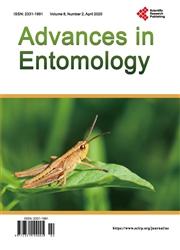Some Natural Plant Extracts Having Biocide Activities against the American Bollworm Helicoverpa armigera (Lepidoptera: Noctuidae)
引用次数: 3
Abstract
In the present research, the toxicity, antifeedant activity and biological effects of ethanolic leaves extract of four medicinal plants named Eucalyptus rostrata, Dodonea viscosa, Rhyza stricta and Cymbopogon schoenanthus were evaluated on 2nd, 3rd and 4th instar larvae of H. armigera under laboratory condition. The results showed that values of LC50 in mg of different plant extracts in mg/100ml of the larval diet can be arranged in an ascending order as follows: Dodonea 7.23 > Cymbopogon 12.59 > Rhazya 14.52 > Eucalyptus 29.42 mg/100ml diet (the least LC50 is more toxic than the higher one). All the tested extracts had antifeedant and starvation effects against the 2nd, 3rd, 4th instar larvae. D. viscose extract possesses the least antifeedant effect even of their higher toxicity. There was clear relation between the percent of starvation and antifeedant of the 2nd, 3rd and 4th larval instar. All extracts were nearly the same in their effect on the biotic potential; of the insect, and possess latent effect when tested against 2nd instar larvae, the value of LC 50 of the extract was added to the diet, extracts increased larval duration, deformation between pupae and adult stages, moths sterility, increased as decreasing in females egg production. Other effects were noticed, reduction in percentage of pupation and moths emergence. The plant extracts can be arranged ascending according to percentage of their sterility effects as follows: C. schoenanthus < E. rostrata < R. stricta < D. viscose. All extracts cause disruption on the biology and physiology of the insect, and all extract induced percentages of deformation between pupal and moth stages. The ethanolic extract of the plant leaves of the tested plans may be used for control H. armigera in combination with other methods in the integrated program in order to decrease the buildup of the resistance and protect the environment from chemical pollution.几种天然植物提取物对美洲棉铃虫有杀虫活性(鳞翅目:夜蛾科)
本研究在实验室条件下,研究了四种药用植物桉叶、粘Dodonea粘Dodonea粘杜鹃(Dodonea粘杜鹃)、细纹柳(Rhyza stricta)和沙蚕(Cymbopogon schoenanthus)的乙醇提取物对棉铃虫2龄、3龄和4龄幼虫的毒性、拒食活性和生物学效应。结果表明:不同植物提取物在幼虫日粮mg/100ml中LC50值的大小由大到小依次为:木齿苋7.23 bbb、香蒲12.59 bb1、拉兹亚14.52 bb2、桉树29.42 mg/100ml (LC50值越小毒性越大)。所有提取物对2、3、4龄幼虫均有拒食和饥饿作用。粘胶提取物具有最小的拒食作用,即使其毒性较高。2、3、4龄幼虫的饥饿率与拒食率之间存在明显的相关关系。所有提取物对生物潜能的影响几乎相同;对2龄幼虫有潜在的抑制作用,在日粮中添加该提取物的lc50值,可增加幼虫的持续时间、蛹期和成虫期之间的变形、蛾的不育性,并随着雌蜂产卵量的减少而增加。其他效果还包括化蛹率和飞蛾羽化率的降低。各植物提取物的不育效果按百分比排列顺序依次为:花楸<花楸<花楸<粘胶菊。所有提取物都对昆虫的生物学和生理学造成破坏,所有提取物都引起蛹和蛾期之间的变形百分比。试验植物叶片乙醇提取物可与综合防治方案中的其他方法结合使用,以减少抗性的积累,保护环境免受化学污染。
本文章由计算机程序翻译,如有差异,请以英文原文为准。
求助全文
约1分钟内获得全文
求助全文

 求助内容:
求助内容: 应助结果提醒方式:
应助结果提醒方式:


